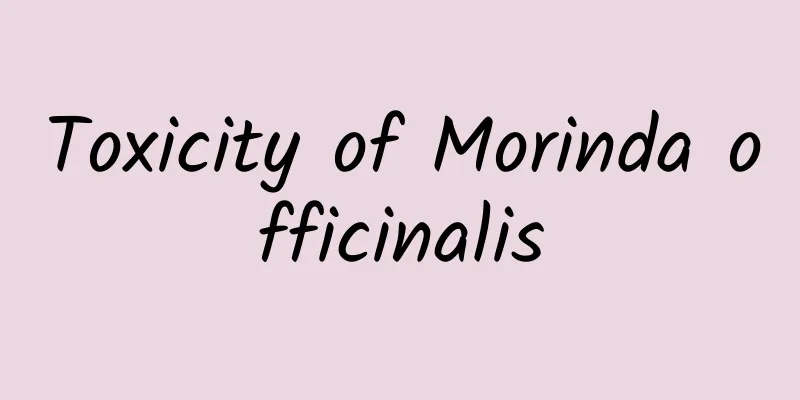Toxicity of Morinda officinalis

|
Morinda officinalis is a Chinese herbal medicine, which is the dried root of Morinda officinalis of the dicotyledonous plant Rubiaceae. The root is flat and cylindrical, slightly curved. It is also known as Morinda officinalis, Morinda officinalis, Morinda officinalis, Morinda officinalis meat, chicken intestines, cat intestines, rabbit intestines, etc. Poria cocos effects: pungent and sweet, mainly used to treat impotence, frequent spermatorrhea, uterine coldness and infertility, irregular menstruation, cold and pain in the lower abdomen, rheumatic arthralgia, and weakness of bones and tendons. Is Morinda officinalis poisonous? Morinda officinalis contains many ingredients with medicinal value. The roots contain anthraquinone ingredients: such as hydroxyisorhizin, hydroxyisorhizin-1-methyl ether, physcion methyl ether, 2-hydroxyhydroxymethylanthraquinone, 1-hydroxyanthraquinone, 1-hydroxy-2-hydroxyanthraquinone, 1,6-dihydroxy-2,4-dimethoxyanthraquinone, 1,6-dihydroxy-2-methoxyanthraquinone, 2-hydroxyanthraquinone; it also contains cyclopentane ingredients, such as crystal orchid glycoside; it also contains glucose, mannose, β-sitosterol, and palmitic acid. Vitamin, nonadecane, 24-ethylcholesterol, etc. The root bark contains reducing sugars, glycosides, cardiac glycosides, flavonoids, steroidal triterpenes, carbohydrates, and citric acid; it also contains 23 rare elements such as potassium, calcium, and magnesium, 15 of which are essential nutrients for the human body. The lead content in the root bark was lower than that in the wood core, and the content of 16 nutrients such as iron, manganese, and zinc was higher than that in the wood core. The root of Morinda officinalis is oblate and cylindrical, slightly curved, of varying lengths, with a diameter of 1-2 cm. The surface is earthy yellow or grayish yellow-brown, some with slight bluish purple, with longitudinal wrinkles and sunken longitudinal lines, some are constricted or the cortex is broken horizontally to expose the wood, shaped like chicken intestines. The texture is tough, the fracture surface is uneven, the cortex is 5-7mm thick, light purple, and the wood is 2-4mm in diameter. Slight odor, slightly bitter and astringent taste. Use Morinda officinalis in combination with Rhizoma Cynomorii, Curculigo orchioides, Lycium barbarum and other drugs to treat impotence and infertility caused by yin deficiency and hyperactivity of fire, such as Zanyu Pills in Jingyue Complete Book. It is combined with drugs such as galangal, cinnamon powder, and Evodia rutaecarpa to treat coldness in the lower abdomen, cold pain in the lower abdomen, and irregular menstruation, such as the "Baji Pills" in the "Ju Fang". It is combined with wild ginseng, Cistanche deserticola, Eryngium arborescens, Cuscuta australis and other medicines to treat frequent nocturnal emission, such as "Medical Inventions": Baji Pills. "Bencao Qiuzhen": Morinda officinalis is called an important medicine for nourishing the kidney and strengthening yang, which can cure five kinds of fatigue and seven kinds of injuries, strengthen yin and benefit the kidney, because of its moisturizing nature. "Ben Jing": It can treat wind and dampness, impotence, strengthen tendons and bones, soothe the five internal organs, soften the liver, increase will and nourish blood. Is Morinda officinalis harmful? Morinda officinalis has no toxic side effects. This product warms the kidney and nourishes the kidney yang. It has a clear and moist nature. It is not as dry and dispersing as Xianlingpi, but it is only suitable for symptoms of yang deficiency and cold. It should not be taken by those with yin deficiency and excessive fire, or excessive cold and dampness. It is not suitable for use alone by those with yin deficiency and excess fire. "Bencao Jingshu" states: "Any disease with intense fire, red stools, bitter taste in the mouth, bad breath, red and swollen eyes, irritability and dry mouth, and dry and constipated bowel movements should be avoided." "Depei Materia Medica" says: "Excessive fire can cause semen loss, yang deficiency can cause water retention, urination can be difficult, and there can be dryness at the corners of the mouth. These four conditions should not be used." |
<<: Toxicity of wild chrysanthemum
>>: Effects and toxicity of mountain tortoise
Recommend
Anti-thrombotic Chinese patent medicine
As living conditions are getting better and bette...
Many countries have recently reported high incidence and death cases. The Chinese Embassy reminds you! Beijing CDC: Be alert——
The Mid-Autumn Festival and National Day holidays...
Colliers: Global Luxury Retail Outlook Report 2022
After the epidemic, luxury goods rebounded quickl...
Can you find "crystal" around Chengdu? Experts: It's actually calcite
This winter, many residents and tourists in Cheng...
The efficacy and function of Astronomy grass
The environment is now seriously deteriorating an...
Which company will be the best at large-scale energy storage technology in the future? The world's largest "power bank"!
Ren Shengquan Recently, the first domestically pr...
The efficacy and function of Aucklandia lappa
Costusroot is a traditional Chinese medicinal mat...
AI can tell where your photos were taken
"Hi! Tomorrow is Mother's Day and my mom...
The efficacy and function of Qianye Duhuo
The world is full of wonders, and Chinese medicin...
The efficacy and function of Corydalis flexuosus
The Chinese medicinal herb Corydalis quinata is a...
The efficacy and function of buttercup
There are many common Chinese medicinal materials...
Tiankeng, unexpected fall
This is the fallen earth It is God's "pi...
The efficacy and function of Quercus alba
White Quercus is a kind of traditional Chinese me...









